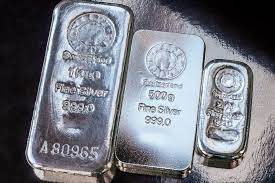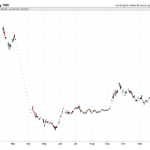If you’re wondering what happens to the price of gold and silver during a recession, you’ve come to the right place. Brace yourself, because when the economy takes a hit, these precious metals tend to shine brighter than ever.
In this article, we’ll delve into the historical trends, factors influencing prices, and the relationship between gold and silver and the stock market during economic downturns.
So, get ready to uncover the hidden treasures that lie within the world of gold and silver during a recession.
Key Takeaways
- Gold and silver prices tend to increase during recessions.
- Demand for gold and silver as safe-haven assets rises during economic uncertainty.
- Central bank policies and geopolitical tensions influence the prices of gold and silver during recessions.
- Gold and silver serve as hedges against inflation and can help diversify investment portfolios during economic downturns.
Historical Trends: Examining the Price Movements of Gold and Silver During Past Recessions
During past recessions, you’ll notice that the price of gold and silver tends to increase. This observation is supported by historical data and can be attributed to several factors.
One key factor is the perception of gold and silver as safe-haven assets during times of economic uncertainty. Investors often flock to these precious metals as a store of value when other investments become volatile.
Additionally, the demand for gold and silver in industries such as jewelry and electronics remains relatively stable, providing a floor for prices.
Furthermore, during recessions, central banks tend to implement expansionary monetary policies, which can lead to inflationary pressures. As a result, investors turn to gold and silver as a hedge against potential inflation.
These combined factors contribute to the upward movement in the prices of gold and silver during recessions.
Factors Influencing Prices: Understanding the Various Factors That Impact the Price of Gold and Silver During Economic Downturns
Understanding the various factors that impact the price of gold and silver during an economic downturn can help you make informed investment decisions.
In times of economic uncertainty, investors often turn to gold and silver as safe haven assets. There are several factors that influence the prices of these precious metals during a recession.
One key factor is the demand for these metals as a hedge against inflation. When inflation rises, investors seek assets that can preserve their purchasing power, and gold and silver have historically been seen as reliable stores of value.
Additionally, the strength of the U.S. dollar plays a significant role in determining the price of gold and silver. As the dollar weakens, the prices of these metals tend to rise, as they’re priced in dollars and become more attractive to foreign buyers.
Other factors, such as geopolitical tensions and central bank policies, also impact the prices of gold and silver during economic downturns.
By understanding these factors, you can better navigate the market and make informed investment decisions.
Now let’s explore why investors flock to gold and silver as safe haven assets during recessions.
Safe Haven Assets: Exploring Why Investors Flock to Gold and Silver as Safe Haven Assets During Recessions
Investors like you often turn to gold and silver as safe haven assets during economic downturns because they’re seen as reliable stores of value. Here are three reasons why gold and silver are considered safe haven assets:
- Intrinsic value: Gold and silver have been valued for centuries due to their limited supply and inherent beauty. They’re tangible assets that hold value in any economic climate.
- Diversification: Adding gold and silver to your investment portfolio can help mitigate risk during recessions. These precious metals have historically shown a negative correlation with other asset classes, such as stocks and bonds.
- Hedge against inflation: During recessions, central banks often resort to monetary easing measures, which can lead to inflation. Gold and silver have served as a hedge against inflation, preserving purchasing power over time.
Understanding the role of gold and silver as safe haven assets is crucial for investors seeking stability during economic downturns.
Now, let’s explore the relationship between the price of these metals and the performance of the stock market during recessions.
Relationship With Stock Market: Analyzing the Correlation Between the Price of Gold and Silver and the Performance of the Stock Market During Recessions
When the stock market experiences a downturn, you can observe a correlation between the price of gold and silver and the performance of the stock market. During recessions, investors tend to flock towards safe haven assets such as gold and silver, which are seen as a store of value and a hedge against economic uncertainty. This increased demand for precious metals drives up their prices. The table below illustrates the relationship between the stock market and the price of gold and silver during recessions:
| Stock Market Performance | Price of Gold | Price of Silver |
|---|---|---|
| Declining | Increasing | Increasing |
| Volatile | Increasing | Increasing |
| Stable | Stable | Stable |
| Recovering | Decreasing | Decreasing |
| Booming | Decreasing | Decreasing |
As the stock market declines or becomes volatile, the prices of gold and silver tend to rise. Conversely, when the stock market stabilizes or starts recovering, the prices of gold and silver usually decrease. This correlation between the stock market and precious metals is driven by investor sentiment and the perception of risk in the market.
Potential Opportunities: Discussing Potential Investment Opportunities in Gold and Silver During a Recession
During a recession, you may want to consider exploring potential investment opportunities in precious metals like gold and silver. These metals have historically been considered safe-haven assets during times of economic uncertainty. Here are three reasons why investing in gold and silver could be a viable option during a recession:
- Hedge against inflation: Precious metals like gold and silver have often served as a hedge against inflation. When the value of fiat currencies depreciates, the price of these metals tends to rise, preserving your purchasing power.
- Diversification: Adding gold and silver to your investment portfolio can help diversify your risk. These metals have low correlation with other asset classes, such as stocks and bonds, which means their prices may move independently.
- Store of value: Gold and silver have a long history of being perceived as stores of value. They’ve been used as currency and have maintained their worth over time.
Considering these factors, it may be worthwhile to explore the potential investment opportunities in gold and silver during a recession.





